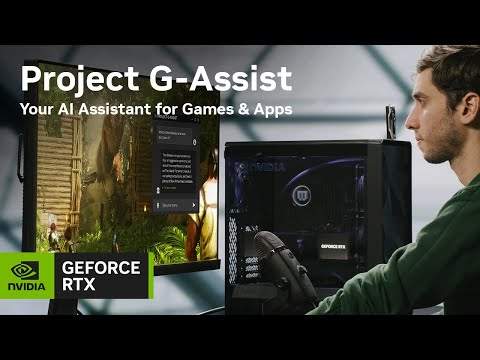Nvidia has recently launched an AI PC segment, known as Nvidia Project G-Assist, which is powered by the RTX platform at Computex 2024. This one is going to be eligible for Microsoft’s new PC and copilot. PCs using RTX-powered artificial intelligence will come with up to GeForce RTX 4070 GPUs. These PCs also feature SoC or systems-on-a-chip with the capabilities of Windows 11 AI PC.
One of the interesting things about RTX AI PCs is the availability of AMD’s Ryzen AI 300 series new processors. According to the company, both devices are unable to boot Copilot and PC experience. Instead, these can receive a free update when available. A few OEMs like MSI and ASUS are building on the platform already.
The main target of the AI assistant is to put gaming knowledge at the fingertips of the players. You can ask any question about your game Or the system performance and the AI assistant will give you context-aware answers. Let’s dig into the article to learn more about Nvidia Project G-Assist.
What Is Nvidia Project G-Assist?
It is an AI-powered assistant that is mainly designed to assist users with in-game tasks. With the help of this assistant, you are able to analyze replays. Besides, this AI assistant provides gaming strategies. In addition, when you ask any question about anything you see on the screen in a game, it will give you answers.
While the assistant takes voice or text prompts, it also takes contextual information from the thing you see on the game screen. Once the data is collected, it will run via “AI vision models.” With the help of these models, this assistant can gain “contextual awareness.” It helps to expand the knowledge database related to gaming. Next, it delivers personalized responses such as speech and text using the data.
Project G-Assist Gaming Demo, Featuring ARK: Survival Ascended
In order to demo the technology on the game “ARK: Survival Ascended,” this company has made a partnership with the game developer Studio Wildcard at the running Computex event in Taiwan. This assistant answered different queries about the objects and in-game creatures in the demo preview. Moreover, it can analyze the difficulty level of games and their objectives.
Customizing the player’s gaming system with AI assistants makes it possible to achieve optimal performance. Besides, it assists in optimizing graphics settings based on your hardware. Moreover, the assistant can give you insights into performance data.
If you are playing an RPG or level-based game, Project G-Assist could hint at the secret item’s location before providing stepwise instructions. This assistant will be able to share the game build order in an RTS. In addition, it can share resource management strategies in order to assist you in getting on level terms with long-time players. You can find out the current loadout Mera in an FPS. Also, you can discover the recommended attachments, which will help you to ensure that you are not at all at a competitive disadvantage.
About Nvidia Project G-Assist — A GeForce AI Assistant:
This AI assistant is now ready to share gaming experiences. For instance, these can now offer gaming strategies and help complex creative workflows. In addition, these help to analyze multiplayer replays.
Nvidia Project G-Assist uses generative AI to allow players to know about different games. With the help of these AI vision models, it is possible to enhance the understanding of LLM for any particular app. Then, these respond as text or speech. Because of context awareness, the AI assistant helps to personalize its responses to any player’s gaming sessions.
G-Assist is able to apply a safe overclock. Also, it helps to reduce power consumption. During this time, it helps to maintain a performance target.
Project G-Assist Performance Tuning:
In order to get smooth gameplay, modern games want the best performance from systems. But it is not so simple to determine the best PC and game settings for your setup.
In terms of performance tuning, this AI assistant is beneficial. As a demonstration, you can check out a GeForce RTX PC that plays CD PROJEKT RED’s game, Cyberpunk 2077. This assistant uses a simple prompt to evaluate the performance and configuration of your system. In addition, it helps to tune this immediately in order to obtain an optimal experience.
This AI Assistant enables you to monitor and graph frame rates along with some other factors, including PC latency, power usage, and hardware statistics. It is capable of finding innovative ways, allowing it to boost performance per watt. For instance, it helps to undervolt GPU dynamically and maintain a frame rate target. If you are a laptop user, you need to prioritize the power usage. The reason is that it helps to determine how long you can play before the battery is depleted.
When you open apps, game menus and control panels, you will find multiple game and hardware settings. With the help of this, scanning the system makes it possible to view something if it is out of order, like not taking complete advantage of refresh rate, display resolution, etc.
It also lets you know what settings do. Also, this assistant informs about the impact of performance. For example, it can say how DLAA and DLSS are different. Besides, it can explain how Ultra Low Latency Mode and NVIDIA Reflex are different in-game.
How This Gaming AI Assistant Works:
It takes input like text or voice from a player. Also, it takes a snapshot of the game window to see what is inside it. Then, the snapshot is fed into such models, offering context awareness for LLM. It is linked to a game knowledge database. Remember that the LLM’s output is a personalized response, such as text or speech from artificial intelligence. It depends on what is happening in-game.
Developers are capable of customizing the language and vision models of this AI assistant for a particular app or game. It can deliver huge accuracy. After that, you should run the custom AI models on the cloud. GeForce RTX AI PCs and laptops boost the models locally.
RTX Video:
NVIDIA RTX Video is a super-resolution feature powered by artificial intelligence. This feature is available for developers as an SDK. It enables them to integrate AI natively for different purposes like sharpening, video upscaling, and HDR conversion.
There will be another integration— video editing software. Blackmagic Design’s DaVinci Resolve and Wondershare Filmora are examples of video editing software that allows editors to boost video quality up to 4K resolution. The VLC media player might offer the benefits of RTX Video HDR.
Besides, the company has announced that ACE generative AI microservices will be available. Its main target is to create advancements in digital human technologies in gaming, customer service, healthcare, and other sectors. You can see the following in this launch:
- NVIDIA Riva ASR, TTS, And NMT: It refers to technologies for translation, text-to-speech conversion, and automatic speech recognition.
- NVIDIA Nemotron LLM: This advancement is for contextual responses and language understanding.
- NVIDIA Audio2Face: It is for facial animation from audio tracks.
4x Faster, 3x Smaller Models With The RTX AI Toolkit:
The AI ecosystem has made multiple open-source models for app developers. In most cases, the models have already been trained for general purposes. These are made to run in a data center.
The company launched the RTX AI Toolkit, which assists developers in producing app-specific AI models running on PCs. In this case, you need to know about the RTX AI Toolkit, which is a suite of tools and SDKs that can be used to customize models. Besides, it helps to deploy and optimize models on RTX AI PCs. In order to get developer access more widely, you will need the RTX AI Toolkit, which you can get later.
Customizing a pre-trained model for developers is possible with the open-source QLoRa tools. After that, these are capable of using the NVIDIA TensorRT™ model optimizer. The aim is quantizing models in order to consume up to three times less RAM. After that, NVIDIA TensorRT Cloud is used to optimize the model in order to get the best performance across the RTX GPU lineups. As a result, it can perform four times faster than a pre-trained model.
AI Inference Manager SDK
You can now get the new NVIDIA AI Inference Manager SDK in early access. It helps to deploy ACE to PCs. In addition, it is able to preconfigure the computer or PC with engines and the required AI models.
Adobe, Blackmagic Design, and Topaz are the software partners that integrate components of the RTX AI Toolkit within innovative apps. The purpose, in this case, is boosting AI performance on RTX PCs.
Adobe and NVIDIA companies have been collaborating continuously in order to offer excellent customer experiences in imaging, video, design, 3D, etc. If you use RTX PCs, you will find TensorRT 10.0 offering unmatched performance. Creators and developers will also get AI-powered capabilities. It allows you to create content in more creative ways using Photoshop and other popular creative tools.
TensorRT-LLM is one of the components of the RTX AI Toolkit. It is used to integrate into popular apps and developer frameworks, including
- LangChain,
- Automatic1111,
- ComfyUI,
- AI,
- LlamaIndex,
- Oobabooga and
- AI.
Nvidia Project G-Assist — A Glimpse Into The Future:
In the future, it is expected to get immediate assistance related to
context-awareness with a complex creative workflow in apps used for video and photo. You can also expect to have an AI coach who will analyze your multiplayer replays. In addition, the coach will help you to learn different strategies in order to increase your ranks.
The Bottom Line:
In this article, we have discussed the Nvidia Project G-Assist. NVIDIA RTX Video is a popular super-resolution feature that is powered by artificial intelligence. Besides, it is compatible with Microsoft Edge, Google Chrome, and Mozilla Firefox. With the help of this, developers are capable of integrating AI to reduce compression artifacts.
Video editors use RTX Video in order to increase the video quality to 4K resolution. Besides, RTX Video is the reason behind the conversion from standard dynamic range source files into HDR. You can expect the free media player VLC media to include RTX Video HDR in addition to those super-resolution capabilities that are available already.







